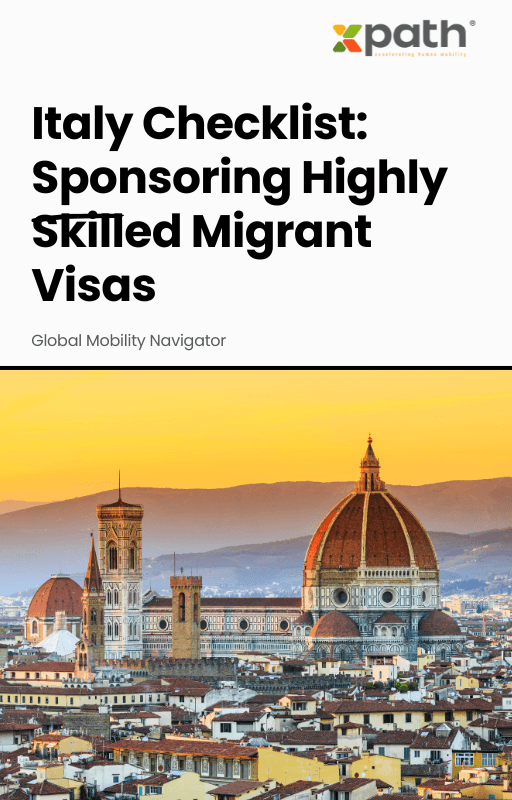Italy Checklist: Sponsoring Highly Skilled Migrant Visas
Grab a copy of a guide to international employee relocation
View E-bookAsk any HR leader about managing a global workforce, and you’ll likely witness a moment of dread at the mention of “Excel spreadsheets.” While Excel has long been the go-to tool for tracking assignments, immigration, compliance, and relocations, times are rapidly changing. As global mobility programs get increasingly complex and talent becomes more borderless, organizations are trading in spreadsheets for smart, unified mobility solutions—and for good reason. Let’s unpack why the shift is happening, what’s driving it, and how modern platforms (like xpath.global) are revolutionizing how HR teams move talent worldwide.
If you think global mobility is just about moving people from point A to point B, think again. Today’s global workforce is mobile, distributed, and diverse. In Mercer’s 2023 Global Talent Trends report, 70% of organizations said they’re embracing flexible work across borders, while 61% expect an increase in cross-border assignments post-pandemic. As remote work and new markets unlock opportunities, managing mobility has become a strategic lever for attracting, deploying, and retaining top talent—far beyond just handling logistics.
Let’s face it: Excel is great—for budgets. But when it comes to running a seamless mobility program across dozens of countries, multiple time zones, and ever-changing compliance regulations, spreadsheets get ugly fast. HR teams relying on manual tracking face:
– Version control nightmares and outdated data
– Poor visibility and reporting across business units
– Repetitive manual entry that invites human error
– High risk of compliance misses and data security gaps
According to Ernst & Young, 39% of global mobility leaders cite “lack of technology” as the main barrier to program effectiveness. So, it’s no wonder that over two-thirds of HR executives expect to increase investment in digital mobility management tools over the next two years (KPMG’s 2022 Global Assignment Policies and Practices Survey).
Gone are the days when HR leaders used intuition (and incomplete spreadsheets) to make critical people decisions. The rise of unified smart mobility tools means real-time data, integrated workflows, and policy automation all in one place. Platforms like xpath.global allow you to:
– Securely centralize all assignment data, immigration docs, and vendor contracts
– Trigger workflows for relocation, tax, and compliance automatically
– Access dashboards for cost projection, policy benchmarking, and risk alerts
Case in point: A tech company migrating from Excel to a smart global mobility solution reduced assignment processing time by 40%, while cutting compliance errors by half. That’s more time for strategic talent planning, less time chasing missing paperwork.
So what’s holding some HR teams back? Change management. Moving away from Excel is like trading in your old flip phone for a smartphone—it’s better, but change is hard. Statista reveals that 29% of digital transformation projects fail due to employee resistance. To overcome this, organizations should:
– Involve end-users early in the platform selection process
– Provide role-based training and ongoing support
– Align mobility tool adoption with broader HR tech strategy (integrating with payroll, ATS, etc.)
Success stories abound. One European multinational streamlined cross-border moves for over 50 countries by linking their global HRIS with xpath.global. Result? A 30% improvement in mobility program satisfaction, and critical time saved for HR specialists worldwide.
The real magic happens when mobility tools empower HR to move from “process administrator” to “strategic advisor.” With data-driven insights—from cost forecasting, to employee experience analytics, to compliance heatmaps—talent leaders can proactively recommend where to post talent, anticipate cross-border risks, and demonstrate ROI to the C-suite.
With AI and machine learning, smart tools like xpath.global are now forecasting assignment trends, automating document collection and flagging policy exceptions in real time. According to Deloitte, organizations using advanced analytics in mobility are 2x as likely to report improved workforce planning outcomes.
Global mobility is evolving fast. Expect more investment in cross-border remote work management, mobile app-based employee experiences, self-service relocation tools, and integrated vendor marketplaces. As the workforce becomes truly global, smart mobility solutions will be essential—not just a “nice to have.”
If you’re still wrestling with complex spreadsheets, limited visibility, or compliance headaches, it’s time to rethink your approach. Industry leaders are trading manual tools for platforms designed to make mobility seamless, scalable and compliant in one fell swoop. The future isn’t just digital—it’s intelligent.
Why should HR switch from Excel to a smart mobility tool?
Excel is prone to human error, lacks real-time visibility, and isn’t secure enough for managing sensitive global assignments. Smart mobility platforms centralize data, automate tasks, improve compliance, and provide valuable analytics—saving both headache and resources.
How do global mobility solutions like xpath.global integrate with existing HR systems?
Many modern platforms, including xpath.global, offer robust APIs and integration options, enabling seamless data flow with your HRIS, payroll, ATS, and more—reducing duplication and manual intervention.
Is it difficult to transition from Excel to a global mobility solution?
While any change comes with challenges, vendors like xpath.global provide onboarding support, user training, and integration services designed to smooth the transition, while minimizing operating disruptions.
What’s the ROI of upgrading to a mobility management solution?
Organizations typically see significant reductions in processing times, error rates, and compliance risks—plus the ability to make better strategic decisions. The long-term ROI comes from cost savings, risk mitigation, and improved talent outcomes.
Ready to transform your mobility program? Explore xpath.global’s solutions.

Italy Checklist: Sponsoring Highly Skilled Migrant Visas
Grab a copy of a guide to international employee relocation
View E-book